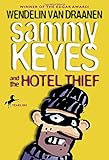Lesson 5: Red Herrings
Lesson Plan
Sammy Keyes and the Hotel Thief | 840L

- Learning Goal
- Identify red herrings used to mislead the reader.
- Duration
- Approximately 2 Days (45-50 minutes for each class)
- Necessary Materials
- Provided: Clue Tracker from Lesson 2, Clue Tracker Worksheet from Lesson 2 (Student Packet, p. 15), Suspects Chart from Lesson 3, Predictions Chart from Lesson 4, Predictions Worksheet from Lesson 4 (Student Packet, p. 27), Red Herrings Worksheet (Student Packet, p. 31), Main Mystery Worksheet (Student Packet, p. 32)
Not Provided: Red markers or pens, chart paper, markers, Sammy Keyes and the Hotel Thief by Wendelin Van Draanen
-
Before the Lesson
Read Chapters 17-19; Complete Student Packet Worksheets for Chapters 17-19
-
Activation & Motivation
Remind students of the meaning of a disguise—a change in appearance that misleads other people. For example, Clark Kent has a double identity as Superman. What other double identities or disguises can students think of? Record the students’ ideas on chart paper. Ask students if they’ve ever disguised themselves or know someone who has. (Students may answer they disguised themselves at Halloween, or in a school play, etc.). Create a list of the disguises your students have used.
Ask students about double identities or disguises they might have noticed in Sammy Keyes and the Hotel Thief. Engage the class in a discussion about the many sides of the characters in the book and how these identities give readers clues as they read.
-
Teacher Modeling

will explain that mystery authors also disguise details in their books to mislead readers. These misleading details look like clues, but they’re actually red herrings. I will explain that a red herring is a detail that appears to be a clue, but really isn’t. Long ago, during fox chases (a game where dogs hunted foxes), smelly, smoked herring fish (which are red in color) were used to lead fox hounds on a false chase. Today, the term “red herring” is used to refer to false clues in mysteries. Red herrings take readers on the wrong path to a mystery’s solution. They keep readers in suspense for all or most of the story so that the reader doesn’t figure out the mystery too quickly or too easily.
Now that I have finished reading Sammy Keyes and the Hotel Thief, I will look back at my Predictions Chart (from Lesson 4) to see if I made a correct prediction about the hotel thief. My prediction states that Bill Eckert/Rockin’ Rick was the thief. This is incorrect. Now I will look back at my Clue Tracker (from Lesson 2) to see which details lead me to this wrong prediction. I see that my prediction was based on the following clues: Hudson’s dog found a buried purse in the yard, Bill Eckert is Hudson’s tenant, and Sammy bumped into Bill as he was holding an armful of shopping bags.
I can conclude that these details were meant to mislead me into believing Bill Eckert was a major suspect in this case. I will circle these clues with a red pen to show that they are red herrings. I will record the red herrings I found on chart paper. I will label the chart “Red Herrings Chart.”
-
Think Check
Ask: "How can I tell the difference between a real clue and a red herring?" Students should respond that can tell the difference by reviewing clues that lead to wrong predictions and clues that lead you to the correct solution.
-
Guided Practice

will review two additional predictions we recorded on our Predictions Chart (from Lesson 4) to see if our predictions were correct or incorrect. If the predictions are incorrect, we will look back at our Clue Tracker (from Lesson 2) and Suspects Chart (from Lesson 3) to see which clues misled us to make this prediction. For example, we predicted that T.J. was the thief because he needed money. We will look at our Clue Tracker to see which clues misled us to make this prediction. According to our Clue Tracker, Sammy overheard T.J. talking on the phone about borrowing money from his father. He also mentions to Madame Nashira that he’s moving to Jasmine Street, where wealthy people live.
We will circle the misleading clues with a red pen to signify that these details may have been red herrings and record them on the Red Herrings Chart that we started during the Direct Teaching. Note: Focus on predictions that were incorrect.
-
Independent Practice

will look at your predictions that you recorded on your Predictions Worksheet in your Student Packet to see if your predictions were correct or incorrect. (See page 27 in the Student Packet.) If your prediction was incorrect, you will look back at your Clue Tracker Worksheet in your Student Packet to find the clues that lead you into making this wrong prediction. (See page 15 in the Student Packet.) You will circle the misleading clues with a red pen to signify that these clues were red herrings. You will then write the red herrings that you found on your Red Herrings Worksheet in your Student Packet. (See page 31 in the Student Packet.)
You will also record the solution to the main mystery, using the Solution to the Main Mystery Worksheet in your Student Packet. (See page 32 in the Student Packet.)
-
Reflective Practice

will share our red herrings with the class We will discuss how many different red herrings were found and/or which details seemed to mislead several students. Now that we know the solution to the story, we will look back at our predictions from Lesson 4 to see who made the correct prediction.
Build Student Vocabulary incriminating
Texts & Materials
Standards Alignment
(To see all of the ReadWorks lessons aligned to your standards, click here.)
